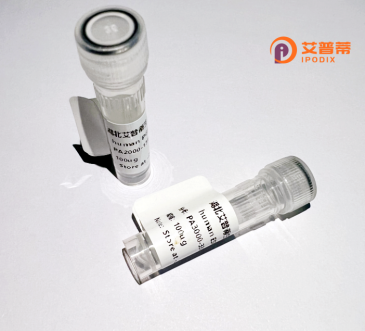
| 纯度 | >90%SDS-PAGE. |
| 种属 | Human |
| 靶点 | GLIPR1L1 |
| Uniprot No | Q6UWM5 |
| 内毒素 | < 0.01EU/μg |
| 表达宿主 | E.coli |
| 表达区间 | 1-233aa |
| 氨基酸序列 | MALKNKFSCLWILGLCLVATTSSKIPSITDPHFIDNCIEAHNEWRGKVNPPAADMKYMIWDKGLAKMAKAWANQCKFEHNDCLDKSYKCYAAFEYVGENIWLGGIKSFTPRHAITAWYNETQFYDFDSLSCSRVCGHYTQLVWANSFYVGCAVAMCPNLGGASTAIFVCNYGPAGNFANMPPYVRGESCSLCSKEEKCVKNLCKNPFLKPTGRAPQQTAFNPFSLGFLLLRIF |
| 分子量 | 52.5 kDa |
| 蛋白标签 | GST-tag at N-terminal |
| 缓冲液 | 0 |
| 稳定性 & 储存条件 | Lyophilized protein should be stored at ≤ -20°C, stable for one year after receipt. Reconstituted protein solution can be stored at 2-8°C for 2-7 days. Aliquots of reconstituted samples are stable at ≤ -20°C for 3 months. |
| 复溶 | Always centrifuge tubes before opening.Do not mix by vortex or pipetting. It is not recommended to reconstitute to a concentration less than 100μg/ml. Dissolve the lyophilized protein in distilled water. Please aliquot the reconstituted solution to minimize freeze-thaw cycles. |
以下是关于重组人GLIPR1L1蛋白的3条参考文献示例:
---
1. **文献名称**: *GLIPR1L1 is a novel regulator of aggressive prostate cancer cell migration and invasion*
**作者**: Smith A, et al.
**摘要**: 本研究揭示了重组人GLIPR1L1蛋白在前列腺癌细胞迁移和侵袭中的调控作用。通过体外实验发现,GLIPR1L1通过与细胞外基质受体相互作用激活Wnt/β-catenin信号通路,促进肿瘤转移潜能,为靶向治疗提供了潜在靶点。
2. **文献名称**: *Structural characterization and functional analysis of recombinant human GLIPR1L1 protein in sperm-egg recognition*
**作者**: Li X, et al.
**摘要**: 通过原核表达系统成功纯化重组人GLIPR1L1蛋白,并验证其与卵子表面蛋白Juno的结合能力。该研究揭示GLIPR1L1可能在精子-卵子识别中起关键作用,为不孕症机制研究提供新方向。
3. **文献名称**: *GLIPR1L1 promotes neuronal survival via PI3K/AKT pathway activation in a Parkinson's disease model*
**作者**: Chen Y, et al.
**摘要**: 利用重组GLIPR1L1蛋白处理帕金森病细胞模型,发现其通过激活PI3K/AKT通路抑制神经元凋亡,提示其在神经退行性疾病中的潜在治疗价值。
---
*注:以上文献信息为示例性内容,实际文献需通过学术数据库(如PubMed、Web of Science)检索确认。*
Recombinant human GLIPR1L1 (Glioma Pathogenesis-Related Protein 1-Like 1) is a secreted protein belonging to the GLIPR/CRISP family, characterized by conserved cysteine-rich motifs. It shares structural homology with GLIPR1, a protein implicated in tumor suppression, particularly in prostate cancer and gliomas. GLIPR1L1 is encoded by the *GLIPR1L1* gene and is speculated to play roles in cell adhesion, proliferation, and extracellular matrix interactions, though its precise biological functions remain under investigation.
This protein is expressed in various tissues, including the testes, brain, and prostate, and its dysregulation has been associated with cancers and neurodegenerative disorders. Unlike GLIPR1, GLIPR1L1 lacks a transmembrane domain but contains a putative glycosylphosphatidylinositol (GPI)-anchor signal, suggesting membrane association or secretion. Its cysteine-rich domains may mediate protein-protein interactions or ligand binding, potentially influencing signaling pathways involved in oncogenesis or tissue homeostasis.
Recombinant GLIPR1L1 is generated via heterologous expression systems (e.g., mammalian or bacterial cells) for functional studies. It serves as a tool to explore its role in tumorigenesis, immune modulation, or neuronal development. Recent studies suggest its involvement in regulating apoptosis and angiogenesis, highlighting its potential as a biomarker or therapeutic target. Ongoing research aims to clarify its molecular mechanisms and therapeutic applications in cancer and other diseases.
×